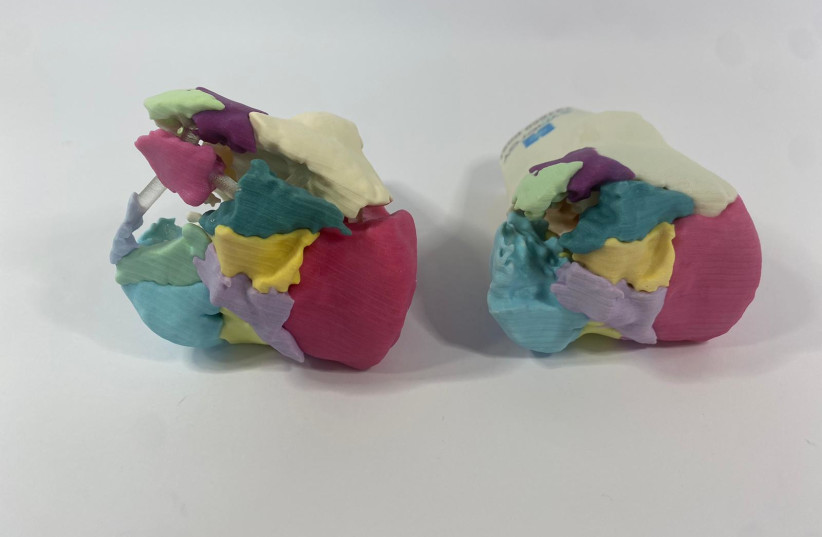Shilo Segev, a 21-year-old soldier in the Givati Brigade and a cadet in the IDF’s officers’ school, was rushed to the Gaza border to help fight terrorists who infiltrated the southern Israeli communities on October 7.
Shot in the leg, his knee was shattered as terrorists surrounded him on the ground and shot at him.
Fortunately, he was evacuated, and while undergoing advanced technology surgery at Hadassah Ein Kerem Medical Center in Jerusalem, his knee was reconstructed using a 3D-printed model in combination with taking bone from his pelvis to complete the shattered bone.
He has just been discharged from the hospital to undergo rehabilitation.
Since recovering from the orthopedic surgery, during which Segev recounted the shocking occurrence, he said, “I’m lucky to have come here into the hands of a professional team that understands bone restoration and reconstruction.”

He recalled that “we spent Shabbat at the base, and early Saturday morning, we were whisked to the Gaza envelope communities. Like everyone else, we didn’t realize the magnitude of the incident at first. There were a lot of unclear issues at this point.”
Battles in Gaza
Segev and the other soldiers of the Gefen Battalion arrived in Ofakim and began searching the city. “Later, we reached Kissufim to help the forces fighting there,” he said.
After fighting for about two weeks in the Gaza border communities and undergoing another month of training and certification at the training base, they entered the Gaza Strip, where they cleared houses and conducted many searches.
“We reached the Jabalya neighborhood, where no IDF force had entered before us. The fighting there was more difficult because of the presence of a large civilian population mixed in with terrorists.”
In the crowded and dangerous neighborhood, they reached a building that they had to clear so that the brigade could use it as a base for ambushing terrorists.
“We had to carry out the mission quietly and not wake up the neighborhood, so they wouldn’t know we were there,” Segev recalled.
The soldiers immediately sensed that something was wrong. “We entered the building and couldn’t see anything. Everything was full of dust, and ropes were stretched from side to side, which aroused our suspicions.”
After he and his partner quietly searched the first floor, they proceeded to the second. “I tried to open the door and felt a slight resistance. I identified a barrel that made it difficult to open the door. I received permission from my commander to start firing into the room but immediately, after a few seconds, the terrorists fired back at us. The bullets hit right next to us, and there were sparks and flashes of light.”
Segev’s partner was wounded, and while the team provided cover, they pulled themselves back and reached a narrow alley outside the building; that was when a barrage of shots were fired at them. “There were serious volleys of fire. My weapon took a bullet, and I couldn’t shoot. At that point, I was shot in the leg and fell to the floor,” Segev said.
While all the soldiers in the team ran for cover, he was left alone in the alley as the terrorists continued to fire at him. “I was alone in the middle of the alley and screamed that I’d been injured. When I realized that I was endangering others and they couldn’t reach me, I started crawling backward to get out.”
After managing to extricate himself while his friends provided cover for him, he was evacuated by helicopter to Hadassah Ein Kerem. “I was conscious in the helicopter the whole way. My leg hurt terribly, and I thought I’d lost it, but all along, I felt like my hand was being held. My friends were with me until I got to the hospital.”
A complicated surgery
When he arrived, Drs. Alona Katzir and Omer Or from the orthopedic department performed emergency surgery on him. The surgeons cleaned his wounds so that they would not become infected and fixed the fractures with a temporary external fixture.
Prof. Yoram Weil, director of the orthopedic trauma unit, who later operated on Shilo again, recalled: “Shilo came to us with a very complex fracture in his right knee from the penetrating energy of the bullet that shattered the bones. After the initial surgery, he underwent major surgery to reconstruct the knee to restore maximum function later on. Given the crushing of the bones, it was a challenge.”
With the help of a dedicated 3D printer from the Israeli company Stratasys, the doctors built a model through which, during the operation, they saw what was missing in Segev’s knee and could reconstruct the bones in the best way possible.
“The surgery was performed accurately and successfully,” Weil said. “After assembling the model in our 3D laboratory, led by Synergy3Dmed, we saw that there was a lack of upper thigh bone, and using a three-dimensional pattern that we built, an appropriate-sized portion of bone was taken from the pelvis to fill in the blanks to create a reasonable reconstruction of the fracture.
“The model helped us reconstruct the fracture and reach a very high level of accuracy and planning. Shilo is already using the knee well. He is supposed to undergo another operation, and within a few months, the fracture will heal, and he will be able to recover fully.”
Segev, who has already begun restorative physiotherapy training in Hadassah’s orthopedic department, said that he’s already seeing an improvement in functioning and is eagerly waiting to start significant rehabilitation.
“I thought I might lose my leg, but luckily, the situation is completely different, and the leg is already improving... It’s crazy to think I could have ended up without a knee or with a crushed bone. From here, I have to finish the surgeries and get back to myself; that’s for sure what will happen.”
